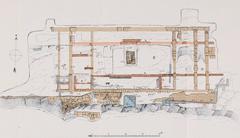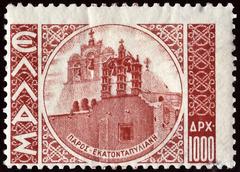Folklore Art Museum of Lefkes, Paros, Greece: Visiting Hours, Tickets, and Travel Guide
Date: 14/06/2025
Introduction
Nestled in the mountainous heart of Paros, the village of Lefkes is an enclave of Cycladic tradition, history, and culture, offering far more than the island’s famous beaches. With its whitewashed houses, labyrinthine alleys, and panoramic views, Lefkes invites travelers to experience a rich tapestry of history shaped by centuries of resilience, artistry, and community life (The Wanderbug; Postcards by Hannah). At the center of this living heritage is the Folklore Art Museum of Lefkes, Paros’ first folklore museum, dedicated to safeguarding and celebrating the island’s rural traditions and material culture (ToParos.com).
This detailed guide covers everything you need to know for your visit: the museum’s history and mission, its unique collection of artifacts, visitor information—including opening hours, ticketing, accessibility, and travel tips—as well as practical advice for exploring Lefkes and nearby attractions.
Table of Contents
- Introduction
- Historical Context of Lefkes Village
- The Folklore Art Museum of Lefkes
- Practical Visitor Information
- Exhibitions and Educational Programs
- Nearby Attractions
- Frequently Asked Questions (FAQ)
- Visuals and Media Suggestions
- References
Historical Context of Lefkes Village
Origins and Early Settlement
Lefkes stands at approximately 300–350 meters above sea level, making it one of Paros’ most significant historic villages. Founded in the 15th century by settlers seeking refuge from pirate raids, its inland location allowed Lefkes to flourish as the island’s medieval capital. The village’s winding alleys and whitewashed houses reflect its defensive past and Cycladic architectural style (The Wanderbug; Postcards by Hannah).
Medieval Prosperity and Venetian Influence
Under Venetian rule (13th–16th centuries), Lefkes prospered. Venetian architectural features—arched passageways, fortified homes, and marble accents—remain visible today. The village thrived on agriculture, especially olive and grape cultivation, sustained by fertile hills (The Common Wanderer).
Decline and Modern Revival
As piracy waned and coastal settlements expanded, Lefkes’ population declined throughout the 19th and 20th centuries. By the late 20th century, it was home to around 500–545 residents. The revival of tourism has since reinvigorated the village, celebrated now for its authenticity, tranquility, and cultural vibrancy (The Common Wanderer).
The Folklore Art Museum of Lefkes
Foundation and Mission
Founded by the “Yria” Cultural Association, the Folklore Art Museum of Lefkes was the first of its kind on Paros. Its mission is to preserve and interpret the material culture of Lefkes and Paros, with a collection built from authentic donations by local families (ToParos.com). This community-driven ethos supports the safeguarding of rural traditions and crafts.
Collection and Exhibits
The museum’s collection vividly illustrates everyday life on Paros from the 19th to early 20th centuries:
- Textiles and Needlework: Handwoven fabrics and embroidery, showcasing traditional craftsmanship.
- Spinning Wheels and Looms: Tools reflecting home-based textile production.
- Agricultural Implements: Plows, sickles, grape presses, and olive oil tools.
- Domestic Utensils and Furniture: Household objects and furniture, including carved chests and cradles.
- Traditional Costumes: Ceremonial, festive, and everyday garments.
- Ecclesiastical Items: Icons, silver chalices, and embroidered altar cloths from local churches.
- Photographic Archives: Early 20th-century village scenes, family portraits, and artifacts (Parosweb; Paros Greece).
Educational and Cultural Role
The museum fosters cultural education through workshops, lectures, and events—often in collaboration with local schools and artisans. Activities include weaving, bread-making, and storytelling sessions, making the museum a hub for intergenerational dialogue (Cycladia).
Practical Visitor Information
Location and Accessibility
The Folklore Art Museum is centrally located in the pedestrianized heart of Lefkes, just off the main square. The village’s cobbled streets and steps may present challenges for those with mobility issues, and visitors should park at the village entrance. Contact the museum in advance if accessibility is a concern (Postcards by Hannah).
Opening Hours and Tickets
- Opening Period: 25 June – 5 September
- Hours: 10:00–13:00 and 18:00–22:00, closed Mondays
- Admission: €1 per person; discounts or free entry may apply for children, students, or during cultural events
- Payment: Cash preferred
- Contact: +30 22840 41614 & 41605; [email protected]
- Official Information: Greeka
Getting to Lefkes
- By Public Bus: Paros KTEL runs regular buses from Parikia to Lefkes (25–30 min, €1.80–€3.00). Tickets from kiosks or the driver.
- By Taxi/Private Transfer: Taxis start around €20. Book in advance for convenience.
- By Rental Car/Scooter: Roads are well maintained; parking is at the village entrance.
- On Foot/Bicycle: The Byzantine Road offers a scenic hike or cycle route to Lefkes (The Wanderbug).
Exhibitions and Educational Programs
- Permanent Exhibition: Thematic displays of textiles, tools, costumes, and domestic interiors. Collections are regularly updated with new donations (Paros Greece).
- Temporary Exhibitions: Rotating displays on local crafts, festivals, and maritime heritage, often paired with workshops and lectures (Cycladia).
- Workshops: Weaving, embroidery, and bread-making offered for all ages, especially during festivals and school visits (Visit Greece).
Nearby Attractions
Enhance your visit by exploring:
- Church of Agia Triada: A Byzantine basilica with rare icons.
- The Byzantine Road: An ancient hiking trail to Prodromos.
- Local Artisan Workshops: Marble carving, ceramics, and textile shops.
- Traditional Taverns: Sample Parian cuisine and local wines (The Common Wanderer).
Frequently Asked Questions (FAQ)
Q: What are the museum’s visiting hours?
A: 25 June – 5 September, 10:00–13:00 and 18:00–22:00, closed Mondays.
Q: How much is admission?
A: €1 per person; discounts for children, students, and on special days.
Q: Is the museum accessible for those with mobility issues?
A: Some limitations due to cobbled streets and steps; contact ahead for advice.
Q: Are guided tours available?
A: Occasionally, especially during festivals and by prior arrangement.
Q: Can I take photographs?
A: Generally allowed, but always check for restrictions near sensitive exhibits.
Q: How do I get to Lefkes from Parikia?
A: By public bus (25–30 min), taxi, rental car, or on foot via the Byzantine Road.
Visuals and Media Suggestions
To enhance your visit and your trip planning:
- Images: Include high-quality photos of museum interiors, Lefkes’ alleys, and key artifacts.
- Alt Text Examples:
- “Traditional costume display at Folklore Art Museum of Lefkes”
- “View of Lefkes village near Folklore Art Museum”
- Map: Embed an interactive map to the museum in Lefkes.
- Virtual Tours: Seek online 360° tours or video walkthroughs for a preview experience.
Summary and Recommendations
A visit to the Folklore Art Museum of Lefkes immerses you in the tangible and intangible heritage of Paros. The carefully curated collections, lively community role, and the museum’s picturesque setting in Lefkes create an unforgettable cultural experience (ToParos.com; Parosweb). Plan your visit around museum hours, take advantage of workshops or festivals, and explore the charming village and its nearby historical sites for a truly enriching journey (Paros Greece; Cycladia).
For up-to-date information, follow the museum and Paros cultural channels on social media, and consider downloading the Audiala app for audio guides and real-time updates.
References and Further Reading
- The Wanderbug: Lefkes Paros Greece
- Postcards by Hannah: Lefkes, the Ancient Capital of Paros
- The Common Wanderer: Lefkes Paros Guide
- ToParos.com: Places & Museums
- Paros Greece: Museums
- Cycladia: Lefkes Paros – The Village of Art and Tradition
- Parosweb: Lefkes Folklore Museum
- Visit Greece: Museums
- Greeka: Folklore Art Museum of Lefkes
Internal Links:

